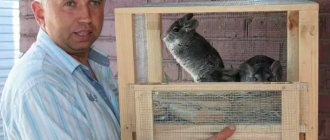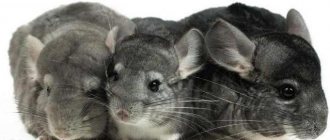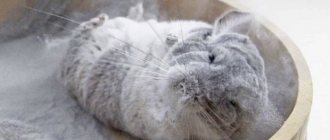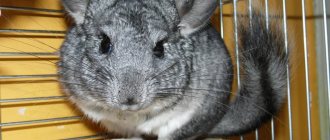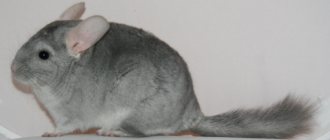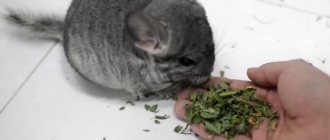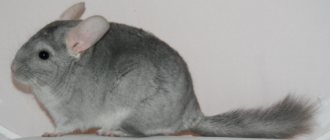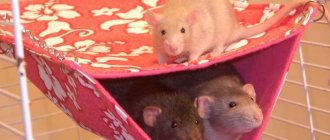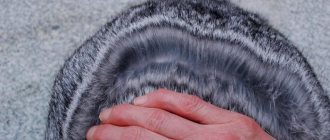Before purchasing a fluffy and very active animal, you need to arrange a place for it to live. Like all rodents, chinchillas love to taste everything. An animal running freely around the house includes chewed furniture, baseboards, walls and electrical wires. This not only outrages the owners, but also poses a danger to the chinchilla itself.
There are commercially produced cages for chinchillas, but not all pet stores can buy them. In addition, a purchased cage provides only the minimum needs of the animal, and the owner usually wants his pet to be happy. You can make a custom cage for a chinchilla yourself.
DIY display case and house for a chinchilla
Cages for chinchillas can be divided into two large groups: for fur farms and for home keeping.
For your home, you can make a cage 80 cm high. But most chinchilla breeders prefer to make a display cage. Feature of the showcase: the height significantly exceeds the width and length. The side walls can be covered with a metal wall or be completely wooden. Often an old cabinet is converted into a display case for a chinchilla. For the same reason, sometimes a display case looks like a bedside table.
Materials and tools
To make a chinchilla display case, you will need the following materials and tools:
- saw with a hacksaw;
- cardboard scissors;
- drill with chisels;
- metal scissors;
- screws and fasteners;
- electric jigsaw;
- alcohol level and measuring tape;
- lumber (natural wood, chipboard);
- glass for doors;
- lattice;
- boards for making shelves, stairs and other accessories;
- hinges to secure the door;
- a lock on the door;
- PVC tape edge (if laminated chipboard was chosen as the main material);
- Screwdriver.
How to make a showcase from an old cabinet
The main requirement for a chinchilla cage is floor space. There should be 0.4 square meters per animal. m, that is, 1 m x 0.4 m. The length and width of the cell in this case are not a dogma - the dimensions can be changed proportionally. For larger numbers of animals, the cage area is increased accordingly.
An old closet is convenient because it requires a minimum of labor when converting it into a house for chinchillas. But it is also dangerous, since cabinets are usually made of particle boards. If an animal tries chipboard on a tooth, it may become poisoned.
- The doors are removed from the cabinet and the inside is converted for animals.
- If there are shelves, they are partially cut out so that the chinchillas can move freely from bottom to top and back.
- If shelves were not provided in the closet, freedom of creativity appears. Shelves for chinchillas can be placed according to your taste. Important! Shelves should be made of natural wood. If it is inconvenient to gnaw on the smooth side walls, then the chinchilla will definitely try the horizontally located ones.
- A hole is cut out in the top of the cabinet for air circulation. The hole is covered with a metal mesh.
- Instead of cabinet doors, wooden frames covered with metal mesh are made. You can simplify your work and make frames from “original” doors by cutting holes in them along the entire length. You only need to leave strips around the perimeter of the door about 10 cm wide.
- It would be ideal if the cabinet had lower drawers. Then the floor in the main part of the display case is removed and replaced with a mesh. A tray for litter, feed and garbage is placed under the mesh. In this case, you won’t have to open the entire display case to clean out the chinchilla’s cage.
- If desired, the side walls of the display case can also be made mesh.
Where does the rodent live?
Through experience, experts came to the conclusion that a special display cage would be the optimal habitat for this rodent. Such display cases can be found in specialized stores, but if a person who wants to have a chinchilla in the house has certain plumbing and carpentry skills, he can save a lot of money by making this place for the future pet to live with his own hands. Let's try to figure out what a showcase is and how it differs from an ordinary cage?
Imagine your grandmother's sideboard, or rather, the upper part of it. This is a cabinet with doors at the bottom and glass shelves at the top, again behind glass doors that can be made sliding or opening. This upper part is the showcase. For a chinchilla, the shelves can be made of plywood, and the glass doors can be replaced with fiberglass material or something similar - as long as light penetrates.
It must be said that a chinchilla will feel much more comfortable in a display case than in a cage, and there are many reasons for this.
- The showcase is more spacious than the cage.
- The cage is made of twigs, there is nowhere to hide in it, and the chinchilla needs its own closed hole. Showcases are optimally adapted for this purpose - the owner can improvise with closed areas quite freely.
- There is more space in the display case than in a cage, because its depth can be made to any size.
- Various natural materials that the owner can use to build a display case will suit the rodent more than metal rods. Chinchillas prefer secluded places where they can hide if something happens, and if they are made of wood, that’s just great.
- A rodent located behind the glass of a display case creates less noise and does not disturb the owners as much.
- It can be easily removed from the display case if several doors are provided in the front wall.
- If garbage constantly falls out of the cage through the bars, then a solid wall will prevent this unpleasant feature, besides providing access to each “floor” of the display case, cleaning will not take much time.
- The display case can be “camouflaged” if it is made from materials that match the color of the furniture set.
- If you equip the display case with wheels, it can move from room to room in order to create an acceptable temperature regime for the rodent and not overheat it. We should not forget that temperatures above 25 degrees Celsius can cause heat stroke in a chinchilla, because these animals come from the highlands of the Andes of the South American continent.
Having come to the conclusion that a showcase will be the most convenient habitat for a chinchilla, you need to pay attention that you can make a showcase yourself from wood, aluminum profiles, and plastic structures. There is a certain set of requirements for the manufacture of display cases:
- the smallest space for a chinchilla should not be less than 800x800x500 mm;
- when keeping a larger number of individuals, the sizes increase multiple;
- the materials from which the display case is made must be quite durable and safe, since any rodents have the habit of testing them;
- the display case should be dry, warm, well (but not excessively) lit, and have good ventilation;
- During manufacturing, sharp edges and protruding corners of the panels, which could cause accidental injury to the pet, should be removed.
Showcase from scratch
When making a display case from scratch, you will need a solid back panel made of wood and timber for the frame. Everything else can be covered with metal mesh. In addition, you will also need:
- screwdriver;
- self-tapping screws;
- jigsaw;
- hinges for doors;
- drill;
- drill;
- PVC tape.
Since the display case is made individually, taking into account the size of the room in which the chinchillas will live, and the location of other furniture in the room, drawings are usually not made. The length, width and height of the future display case are measured on site and the required amount of materials is calculated. An approximate drawing of the future showcase looks like this:
The vertical supports of the frame also serve as legs if the floor in the display case is mesh and there is a garbage tray underneath it.
The photo shows a display case for several chinchillas with the expectation of raising young animals. In this case, the display case was made from scratch and the specified dimensions were used.
Sometimes the display case is placed in the corner of the room. But a corner display case for chinchillas is more difficult to make and requires at least minimal woodworking skills.
For such a showcase as in the photo, you will need two solid panels, knocked down at right angles. It will not be difficult for a carpenter to make such a corner display case, and other chinchilla owners can make their work easier by converting an old corner cabinet to suit the needs of their chinchillas.
On a note! You can make a display case from scratch only if you are absolutely sure that the chinchillas are here to stay.
If animals are kept for a short period of time, repairs will have to be made after them.
A simpler version of a corner showcase can be made by using walls to enclose the space.
- A couple of vertical bars of the required height are placed on the walls. They must cover the habitable part of the display case.
- On top of these bars two horizontal ones are nailed.
- It is best if the metal mesh is located inside the cage. That is, first a mesh is attached to the upper bars, then the bars are nailed to the wall.
- A similar operation is performed below.
- To protect the wall from attempts to sharpen teeth on it, the sides can also be covered with a metal mesh.
Note! The bottom of the cage should not reach the floor of the room if it is made of mesh. - If there is a fear that the chinchilla will injure its paws on the mesh, the bottom is made of a solid wooden or plastic shield. The same applies to “regular” storefronts. In this case, a suitable-sized tray for excrement is placed at the bottom of the display case or the wood is covered with waterproof, dense material.
- The screen doors are attached to the vertical side bars. You can make two doors, or one wide one. Also, for ease of cleaning, you can divide the doors vertically, making them open independently. Then to clean the display case it will be enough to open only the bottom half.
- Inside the display cases, shelves are screwed at different levels on which chinchillas will run.
- After the main part of the future home is ready, the heads of all bolts and screws are covered with plugs, since chinchillas often try to sharpen their teeth on them. To prevent the animal from gnawing wooden blocks, they are covered with PVC tape.
On a note! Instead of tape, you can use a tin strip. Tin does not look as beautiful, but it is more reliable.
If you put a drinking bowl and feeder in the cage, then the dwelling will be ready to receive inhabitants. But for chinchillas to live comfortably in a display case, additional equipment will be required.
Materials and tools
When choosing wood, a natural material that is safe for the health of animals and their owners, the problem of teeth grinding is also solved. Making your shelving unit from solid wood will provide the most durable and long-lasting results. But such material is quite expensive in itself, and also requires processing in several stages - grinding, impregnation with special protective compounds, and varnishing. A cheaper analogue would be laminated chipboard - this material does not require special processing, is easy to care for, and products made from it look good in the interior of an apartment.
To protect the chipboard from the teeth of animals, removable shelves are made of wood; these boards can be easily replaced when they become unusable.
Also, due to the ability of wood to absorb odors and moisture, display cases are sometimes preferred to be made of aluminum profiles and plastic. For the façade of the rack, it is better to take tempered glass 6 mm thick, and a galvanized metal mesh is used for ventilation.
To cover the cut areas, a thin PVC tape of suitable width is suitable. The bottom of the display case is covered with a tray to facilitate cleaning. From the tools you will need to collect the following set of items:
- hacksaw;
- stationery knife;
- drill and drill bits;
- metal scissors;
- self-tapping screws, tie screws;
- electric jigsaw;
- level, roulette.
Tools can be purchased at any hardware store. It is better to buy glass doors with hinges and a lock already installed, otherwise you will need to find tools for working with glass. To make a metal display case, you will also need special drills, pliers and a grinder.
How to set up a chinchilla cage
With shelves alone, the animal will feel uncomfortable. Chinchillas are good jumpers, but they are far from squirrels. Therefore, it will be necessary to make transitions between the shelves. In addition, as nocturnal animals, chinchillas need shelter where they can sleep during the day. First of all, animals need a home.
Making a house
The appearance of the house depends solely on the imagination and skill of the chinchilla owner. The main requirement is that it must be the right size. In a shelter that is too spacious, the animal will feel discomfort, and in a shelter that is too small, it will feel cramped. The simplest version of the house is in the photo below. This is a wooden box with a cut-out entrance.
A more complex version of a large house for a large chinchilla also provides the possibility of attaching a wooden hemp treat to the house.
Otherwise, the owner’s imagination is not limited. You can make houses on several floors, with several entrances, or decorate them with carvings.
Bathing suit
Chinchillas love to swim in the sand, so a bathing suit is also one of the essential items for animals, as is a feeder and drinking bowl. Bathing suits can be bought at a pet store, but they are also easy to make with your own hands.
Hay manger
The feeder is used for feeding grain concentrates and various dried fruits to animals. There should be a separate place for hay. You can make miniature mangers of a classic shape.
They can be made from wire or wooden sticks.
Important! Do not use hay balls intended for decorative rabbits.
Although the animals are often equal in size, the rabbit is not adapted to fit into very narrow crevices. What is safe for rabbits may pose a threat to the life of a chinchilla. In the photo below, the chinchilla just got into the rabbit hay ball and cannot get out of it on her own.
Feeder, water bowl, manger, house, tray and bathing bowl - the display case now has everything a chinchilla needs, except for a small town for physical activity.
Requirements for the showcase
The minimum size of an enclosure for one animal should be 80x80x50 cm. If you plan to keep two pets, then, accordingly, the area should be doubled.
The display case should be made of durable and environmentally friendly materials, since the rodent will probably want to try it on its teeth.
Also among the requirements for a showcase, you should pay attention to the following:
- dryness;
- warm;
- cosiness;
- sufficient lighting;
- good ventilation.
You should pay attention to the fact that there are no sharp corners or wires in the display case, which could injure the animal or drive a splinter into it.
All parts must fit well together, the joints must not have gaps. Important! Keeping a chinchilla in cramped conditions and in violation of the above requirements will lead to the animal getting sick often.
The minimum set of items that are vital for a pet is a feeder, a drinking bowl, and a tray.
For a more comfortable pastime, you will also need a sleeping area closed from prying eyes, a hay feeder, play complexes, and other devices for relaxation and physical activity. We will talk about them in more detail in a separate section below.
Town
Chinchillas are animals prone to obesity, and they need active movement just like food and water. You can make chinchillas move by building them easy-to-climb routes in the “town.”
The town includes:
- running wheel for chinchillas;
- shelves fixed at different levels;
- transitions between shelves.
The variety of transitions is limited only by the imagination and skill of the chinchilla owner.
It can be:
- suspension bridges;
- tunnels;
- stairs;
- swing.
The only requirement for all these products is natural wood without paint or varnish. You can make transitions from unsanded branches of edible tree species. And change it periodically.
The role of a transition, a toy and a place to rest is simultaneously performed by a hammock for a chinchilla suspended in a display case. It is made from dense non-stretch fabric. Denim suits well. They secure it so that the chinchilla can jump into the hammock, but cannot swing it too much.
In addition to shelves and passages, the town must have a running wheel and a treadmill. The wheels are sold in pet stores and are designed for all active small animals. You need to buy a wooden or plastic one, as a metal wheel can be dangerous for a chinchilla. But you can do it yourself.
DIY chinchilla wheel
To make a wheel you will need:
- 2 sheets of plywood with a side of at least 40 cm and a thickness of at least 1 cm;
- up to 10 figured meter slats;
- automobile tension bearing;
- drill;
- drill 12 mm;
- self-tapping screws;
- 2 bolts with a diameter of 12 mm: long and short;
- screwdriver;
- washers for bolts;
- nuts for bolts;
- jigsaw
Manufacturing technology:
- Find the middle in the pieces of plywood and drill holes. Using a jigsaw, cut out 2 circles of 30 cm in diameter.
- One is left, another circle with a diameter of 25–27 cm is cut out of the other. Only a large circle will be needed from this circle.
- The slats are cut into pieces about 15 cm long. The size of the slats depends on the chinchilla. The animal must fit freely into the wheel.
- The cut slats are attached closely to the ends of the circle and the cut out circle.
- Put a washer on the long bolt, insert the bolt from the inside into the wheel, put on another washer and screw the structure with a nut.
- A hole for a bolt is drilled in the wall of the display case.
- The center of the bearing is aligned with the hole in the wall and the bearing is screwed in with self-tapping screws.
- The wheel with the bolt is inserted into the bearing and tightened with a nut from the outside of the display case.
The video shows in sufficient detail how to make a running wheel for chinchillas.
Treadmill
For chinchillas, this is an additional device, and it is easier to buy it in a store. There it can be sold as a treadmill for decorative hedgehogs. She looks like this.
Now the display case contains everything necessary for a happy life for chinchillas. All that remains is to figure out what a walking ball is.
Chinchilla ball
This is a device that a chinchilla should not have. The plastic ball transmits infrared rays very well and heats up from the inside. Chinchillas do not tolerate heat well. Half an hour in such a ball is enough for the animal to die.
In such a ball, some careless owners of small animals let them “walk” in the fresh air and eat the green grass that falls into the cracks of the ball. Juicy food is contraindicated for chinchillas. And the stress of a walk is much more harmful than being in a spacious display case.
How to make it yourself?
If you do not have a suitable cabinet for retrofitting, you can make your own cabinet. To ensure the most comfortable working conditions, you will need to use:
- using a screwdriver;
- with self-tapping screws of various sizes;
- with a jigsaw;
- new door hinges;
- with drill;
- with drill/bag;
- with sealing tape.
Since it is difficult to guess the dimensions, there are no ready-made drawings “for all occasions”. - you will have to make them yourself by measuring the allocated area of the room. Therefore, the appropriate amount of material is selected. This could be a rough sketch for a medium sized room.
Typically, supports are used as legs when the display floor is made of mesh and some clearance is needed between the mesh and the floor to allow a chinchilla waste collection container to be placed under the mesh.
In addition to simple shelves with holes, the chinchilla display case can be equipped with additional accessories. For example, a small house that can be easily made depending on the size of the storefront can serve as a shelter from daylight.
It should not be too big or too tight.
The feeder can be made in the form of a nursery made of wood or the same metal mesh into which hay or other food will need to be placed.
If a chinchilla is limited in physical activity, it will quickly gain weight. Therefore it is good to have a so-called city. It must consist of at least:
- treadmill;
- The shelves are on different levels and are connected by bridges, tunnels or stairs;
- swing/hammock.
Farm cage
A chinchilla cage on a fur farm is almost no different from a rabbit cage. The only differences are an additional shelf above the floor of the cage and a passage for the male, who mates with 4–8 females at once on the farm. You can also make a cage for a fur chinchilla with your own hands.
For this you will need:
- galvanized mesh;
- scissors for cutting metal;
- clamps;
- pliers.
Manufacturing process:
- The mesh is marked and cut into pieces.
- An additional shelf is tightly attached to one of the side parts.
- Then all sides are secured with clamps.
- A door is cut out in the front part of the cage and hung on the fasteners.
- A passage is made in the side walls for the male chinchilla and covered with a small tunnel. The tunnel is needed so that the male can rest.
- They place a feeder, a water bowl, a nursery and a house in the cage and let the chinchillas in.
On a note! You can take a rabbit house.
If necessary, houses are made independently according to the same scheme as for rabbits.
Step-by-step manufacturing instructions
To make a display case for a chinchilla yourself, you first need to draw up a drawing. An interesting suitable option can be found on the Internet - when using, substitute your dimensions to see if you can make the model you like. If you do not have sufficient experience in construction work, it is better to take a simpler drawing, as in this photo:
After all the measurements have been taken and transferred to the diagram, all drawings are made on paper on a reduced scale. At this stage it is important to carefully check that all dimensions are correct.
Then, using a ruler, marker or chalk, the details of the drawing are transferred to life-size pieces of wood or chipboard. Next, the following steps are performed:
- The parts of the rack are cut out from the prepared materials using a hacksaw or electric jigsaw exactly in accordance with the diagram. For metal, a grinder and appropriate cutting wheels are used. If home conditions do not allow you to work with parts, or there are no suitable tools, you can contact a workshop. Such a service will not be free, but still will not require large expenses.
- Windows are cut out in the side walls for ventilation and covered with mesh. Pieces of mesh are cut using metal scissors and then attached with wide-headed screws. To disguise and protect the mounting points, you can use metal profile thresholds.
Windows for ventilation are covered with mesh
- Ventilation holes are also often made in the ceiling - you can cover it entirely with a mesh. It will be convenient to attach fastenings for hanging toys and hammocks to the metal mesh cells.
- In the marked places, drill holes for the tie screws. Their task will be to fasten the parts together.
- First, the rear and side walls are attached to the pallet, then the ceiling is installed using the same principle.
- Install fastenings for shelves and the shelves themselves.
- Screw the door hinges holding the glass facade.
- In places where chipboard cuts are visible, glue PVC tape.
- To protect pets from drafts, the display case must be raised to a height of 30-50cm. For this purpose, you can cut out wooden legs, but it is better to make a bedside table. Then this space under the shelving can be used to store food, sand, bathing suits, toys and other accessories for keeping animals.
- In order to assemble the bedside table, screws and self-tapping screws are used, the hinged door is attached to furniture hinges, and special magnetic fittings can be used as a lock.
